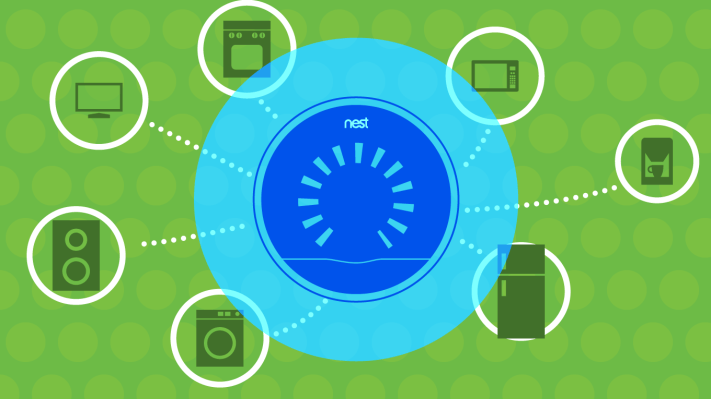“Okay Google, turn down the heat.”
Using Google Now, a homeowner will soon be able to talk to a Nest Learning Thermostat and complain about the heat. And that’s just the beginning.
Google is turning the Nest Learning Thermostat into the hub of smart homes. With the “Works with Nest” developer program, announced today, gadgets, cars and universal remotes will all work with the Thermostat, providing automated actions agnostic of the brand. Suddenly the smart home world is much smaller.
Nest’s Matt Rogers says the idea behind this system is to build seamless and practical experiences in the home and to sell more Nest gadgets at the same time.
The smart home world is widely fragmented. Everything from smart light bulbs to web-connected thermostats are controlled by a separate app and live in their own world. Several gadgets have attempted to bridge brands and conjoin the worlds, but this requires another gadget and another app, thereby compounding the problem.
With the “Works with Nest” program, suddenly, the center of the smart home is the de facto smart home gadget in the Nest Learning Thermostat.
The program leans on the sensors within Nest’s products. The product’s motion detection and machine learning are all tapped and farmed out for use by other gadgets.
The “Works With Nest” Ecosystem
Some of the most popular smart home gadget makers have signed onto the “Works with Nest” program, including LIFX, Logitech, Chamberlain and even Whirlpool. With Whirlpool, when the Nest thermostat notices the homeowner is away, a connected dryer will switch to Fan Fresh mode so the dryer’s cycle doesn’t end early and instead keeps running so clothes stay wrinkle-free. And with LIFX, the web-connected lightbulbs can flash red if a Nest Protect notices elevated CO2 levels or toggle the lightbulbs on to simulate someone’s in the home.
Google also enlisted the help of IFTTT so home owners can program smart switches for the Nest Protect and Thermostat. For instance, with IFTTT, homeowners can program “If my Nest Protect detects smoke, then send a text message to my neighbors” or “If a Nest Thermostat is turned under 72 degrees when the air conditioning is turned on, then send a Twitter DM to me so I can yell at my kids.”
With the “Works with Nest” program, suddenly, the center of the smart home is the de facto smart home gadget in the Nest Learning Thermostat.
Mercedes is also part of the program and select models can tell a connected Nest Learning Thermostat when the driver will be home, activating the heating or cooling at the exact moment so not one cycle is wasted on an empty home.
Sometime in the fall, Google Now will become “Works with Nest” certified, allowing Android users to command their thermostats from anywhere.
Lastly, Google worked with Jawbone to tie the Jawbone UP’s sleep tracker into the Nest Learning Thermostat ecosystem.
“Integrating with Nest is brilliant for our users because it creates a seamless experience for our users,” Jawbone’s Jim Godfrey told me. Travis Bogard, Vice President of Product Management and Strategy, expanded on the thought noting “It’s based on great technology and two sets of insight and data — Nest and Jawbone — combined to create a great experience.”
For Jawbone, the “Works with Nest” program aligns nicely with its core mission of providing an open platform. By pressing the UP’s only button, a Jawbone UP wearer can activate the sleep tracker and have the Nest adjust the climate to a nighttime mode. Likewise, when the wearer wakes up, a single press will change the UP’s mode and switch the Nest to a daytime setting.
Several notable systems are currently absent from this program, including Philips’ Hue smart lightbulbs, smart switches from Lutron and any of the home locking systems. These systems are currently enlisted in Wink’s smart home platform. Dropcam will likely adopt the “Works with Nest” certification as it will soon be under Nest’s ownership.
At first it’s a bit strange to think of a thermostat as the central hub of a smart home, but the Nest Learning Thermostat is packed with enough sensors to make the move logical. The thermostat has a motion detector, Wi-Fi, the goods to learn user behavior and currently untapped wireless protocols of Zigbee. In theory a true smart home shouldn’t need a control panel requiring constant user interaction, but rather actions that are carried out serendipitously.
The Quest For Smart Home Ownership
Google is not alone in its quest to unite the smart-home factions. Innovation powerhouse Quirky just introduced its game plan, which is strikingly similar to “Works with Nest.” Called Wink, the platform integrates different smart objects into one ecosystem, and Quirky has lined up 15 companies who will offer nearly 60 Wink-enabled products by July, including GE, Honeywell and Philips, as well as startups like Rachio.
Google’s $3.2 billion acquisition of Nest essentially catapulted Google’s smart home ambitions ahead of Apple, which just announced its smart-home solution called HomeKit. As Matthew Panzarino explained following its announcement earlier this month, HomeKit allows a developer to use a simple set of controls to toggle the states of devices or send commands to them. HomeKit is the spiritual companion to Apple’s Bluetooth direct and multi-peer frameworks.
It’s a powerful platform that has even more potential than Google’s plan. Yet HomeKit is in its infancy compared to that of Wink or “Works with Nest,” which both will have working solutions in days where Apple’s HomeKit will not bear fruit for months if not longer.
Even an organization as brash as Google will not be able to make all the components of a smart home. Yet this Nest certification program is the next best thing as, if marketed correctly by Google and its “Works with Nest” partners, it could lead to mass adoption of the products it does make. And that alone puts Google in a commanding position.
Works With Nest Announcement Video
